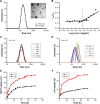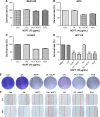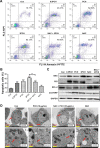Acid-responsive nanoparticles as a novel oxidative stress-inducing anticancer therapeutic agent for colon cancer
- PMID: 30880968
- PMCID: PMC6400122
- DOI: 10.2147/IJN.S189923
Acid-responsive nanoparticles as a novel oxidative stress-inducing anticancer therapeutic agent for colon cancer
Abstract
Objective: Nanoparticles can efficiently carry and deliver anticancer agents to tumor sites. Mounting evidence indicates that many types of cancer cells, including colon cancer, have a weakly acidic microenvironment and increased levels of reactive oxygen species. The construction of nano drug delivery vehicles "activatable" in response to the tumor microenvironment is a new antitumor therapeutic strategy.
Methods: Cinnamaldehyde (CA) was designed to link directly with dextran to form a polymer through an acid cleavable acetal bond. Herein, a novel pH-sensitive drug delivery system was constructed with co-encapsulated 10-hydroxy camptothecin (HCPT). Dynamic light scattering (DLS) analysis, transmission electron microscopy (TEM) analysis, and release kinetics analysis of HCPT-CA-loaded nanoparticles (PCH) were conducted to investigate the physical and chemical properties. The cellular uptake signatures of the nanoparticles were observed by confocal microscopy and flow cytometry. Cell viability, cell scratch assay, apoptosis assay, and colony formation assay were performed to examine the potent antiproliferative and apoptotic effects of the PCH. The antitumor mechanism of the treatment with PCH was evaluated by Western blotting, flow cytometry, and TEM analysis. The pharmacokinetics of PCH were examined in healthy Sprague Dawley rats within 6 hours after sublingual vein injection. We lastly examined the biodistribution and the in vivo anticancer activity of PCH using the xenograft mouse models of HCT116 cells.
Results: Both HCPT and CA were quickly released by PCH in an acidic microenvironment. PCH not only induced cancer cell death through the generation of intracellular reactive oxygen species in vitro but also facilitated the drug uptake, effectively prolonged drug circulation, and increased accumulation of drug in tumor sites. More attractively, PCH exhibited excellent therapeutic performance and better in vivo systemic safety.
Conclusion: Overall, PCH not only utilized the tumor microenvironment to control drug release, improve drug pharmacokinetics, and passively target the drug to the tumor tissue, but also exerted a synergistic anticancer effect. The acid-responsive PCH has enormous potential as a novel anticancer therapeutic strategy.
Keywords: ROS; cinnamaldehyde; colon cancer; hydroxy camptothecin; pH-responsive nanoparticles.
Conflict of interest statement
Disclosure The authors report no conflicts of interest in this work.
Figures











Similar articles
-
Near-infrared light triggered drug delivery system for higher efficacy of combined chemo-photothermal treatment.Acta Biomater. 2017 Mar 15;51:374-392. doi: 10.1016/j.actbio.2016.12.004. Epub 2017 Jan 11. Acta Biomater. 2017. PMID: 28088668
-
Efficacy-shaping nanomedicine by loading Calcium Peroxide into Tumor Microenvironment-responsive Nanoparticles for the Antitumor Therapy of Prostate Cancer.Theranostics. 2020 Aug 2;10(21):9808-9829. doi: 10.7150/thno.43631. eCollection 2020. Theranostics. 2020. PMID: 32863961 Free PMC article.
-
A polymeric micelle with an endosomal pH-sensitivity for intracellular delivery and enhanced antitumor efficacy of hydroxycamptothecin.Acta Biomater. 2019 Apr 1;88:357-369. doi: 10.1016/j.actbio.2019.02.039. Epub 2019 Feb 26. Acta Biomater. 2019. PMID: 30822554
-
The role and mechanism of cinnamaldehyde in cancer.J Food Drug Anal. 2024 Jun 15;32(2):140-154. doi: 10.38212/2224-6614.3502. J Food Drug Anal. 2024. PMID: 38934689 Free PMC article. Review.
-
Cinnamaldehyde: Pharmacokinetics, anticancer properties and therapeutic potential (Review).Mol Med Rep. 2024 Sep;30(3):163. doi: 10.3892/mmr.2024.13287. Epub 2024 Jul 12. Mol Med Rep. 2024. PMID: 38994757 Free PMC article. Review.
Cited by
-
Comprehensive Analysis of the PRDXs Family in Head and Neck Squamous Cell Carcinoma.Front Oncol. 2022 Mar 8;12:798483. doi: 10.3389/fonc.2022.798483. eCollection 2022. Front Oncol. 2022. PMID: 35350568 Free PMC article.
-
Carrier-Free, Dual-Functional Nanorods Via Self-Assembly Of Pure Drug Molecules For Synergistic Chemo-Photodynamic Therapy.Int J Nanomedicine. 2019 Nov 5;14:8665-8683. doi: 10.2147/IJN.S224704. eCollection 2019. Int J Nanomedicine. 2019. PMID: 31806963 Free PMC article.
-
Smart Responsive Nanoformulation for Targeted Delivery of Active Compounds From Traditional Chinese Medicine.Front Chem. 2020 Dec 10;8:559159. doi: 10.3389/fchem.2020.559159. eCollection 2020. Front Chem. 2020. PMID: 33363102 Free PMC article. Review.
-
The role of ferroptosis in colorectal cancer and its potential synergy with immunotherapy.Front Immunol. 2025 Jan 9;15:1526749. doi: 10.3389/fimmu.2024.1526749. eCollection 2024. Front Immunol. 2025. PMID: 39850905 Free PMC article. Review.
-
Cinnamaldehyde-Contained Polymers and Their Biomedical Applications.Polymers (Basel). 2023 Mar 18;15(6):1517. doi: 10.3390/polym15061517. Polymers (Basel). 2023. PMID: 36987298 Free PMC article. Review.
References
-
- Jiang J, Tong X, Morris D, Zhao Y. Toward photocontrolled release using light-dissociable block copolymer micelles. Macromolecules. 2006;39(13):4633–4640.
-
- Chang YT, Liao PY, Sheu HS, Tseng YJ, Cheng FY, Yeh CS. Near-infrared light-responsive intracellular drug and siRNA release using Au nanoensembles with oligonucleotide-capped silica shell. Adv Mater. 2012;24(25):3309–3314. - PubMed
-
- Langereis S, Keupp J, van Velthoven JL, et al. A temperature-sensitive liposomal 1H CEST and 19F contrast agent for Mr image-guided drug delivery. J Am Chem Soc. 2009;131(4):1380–1381. - PubMed
-
- Bikram M, West JL. Thermo-responsive systems for controlled drug delivery. Expert Opin Drug Deliv. 2008;5(10):1077–1091. - PubMed
MeSH terms
Substances
LinkOut - more resources
Full Text Sources

